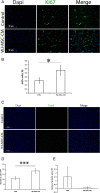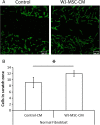Human Wharton's jelly mesenchymal stem cells promote skin wound healing through paracrine signaling
- PMID: 24564987
- PMCID: PMC4055091
- DOI: 10.1186/scrt417
Human Wharton's jelly mesenchymal stem cells promote skin wound healing through paracrine signaling
Abstract
Introduction: The prevalence of nonhealing wounds is predicted to increase due to the growing aging population. Despite the use of novel skin substitutes and wound dressings, poorly vascularized wound niches impair wound repair. Mesenchymal stem cells (MSCs) have been reported to provide paracrine signals to promote wound healing, but the effect of human Wharton's jelly-derived MSCs (WJ-MSCs) has not yet been described in human normal skin.
Methods: Human WJ-MSCs and normal skin fibroblasts were isolated from donated umbilical cords and normal adult human skin. Fibroblasts were treated with WJ-MSC-conditioned medium (WJ-MSC-CM) or nonconditioned medium.
Results: Expression of genes involved in re-epithelialization (transforming growth factor-β2), neovascularization (hypoxia-inducible factor-1α) and fibroproliferation (plasminogen activator inhibitor-1) was upregulated in WJ-MSC-CM-treated fibroblasts (P≤0.05). WJ-MSC-CM enhanced normal skin fibroblast proliferation (P≤0.001) and migration (P≤0.05), and promoted wound healing in an excisional full-thickness skin murine model.
Conclusions: Under our experimental conditions, WJ-MSCs enhanced skin wound healing in an in vivo mouse model.
Figures





References
Publication types
MeSH terms
Substances
Grants and funding
LinkOut - more resources
Full Text Sources
Other Literature Sources
Medical

